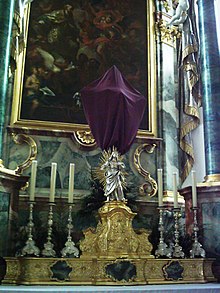The Lenten veil in the Middle Ages
The Lenten shrouds are a very old tradition of the Catholic Church, dating back to at least the 9th century. Lenten shrouds are a smaller version of the Lenten veil ( Fastentuch ), which is still found in Germany and Austria.
Gulielmus Durandus's Rationale divinorum officiorum, one of the most important religious writings of the Middle Ages, stipulates that all images, crucifixes, relics and tabernacles in the house of God be veiled during the period of Lent. Thus Philip the Bold, Duke of Burgundy, had gray and dark sheets (the color of ashes), attached across the sanctuary during Passiontide. At a time when crosses, reliquaries or not, were made of precious metals and encrusted with gemstones, a veil was suspended between the choir and the nave in churches so as to completely hide the sanctuary, attenuating the impact of the crosses’ brilliance when solemnly revealed on Good Friday. Although this rite was adopted both in papal liturgy at the Sessonianum and in that of the Lateran canons, it was not until 1488 that all crosses in Rome were veiled. [13]
In the eighteenth century, large Lenten veils were still used along with the Lenten shrouds across Christianity and as far as in the missions of the Sonoran Desert in Mexico. [14] Whereas some have suggested that the Lenten veil was replaced by the Lenten shrouds, it appears thus that both were in use at the same time and that the former, which was less practical, fell in disuse rather the latter remained. [15]
From suppression to reinstatement after the Second Vatican Council
Before the Council, it seems like Lenten shrouds had taken over most of the church interior, to include even the candlesticks. [16]
In 1969, in the wake of the Second Vatican Council, the Sacred Congregation of Rites on the Revised Liturgical Year and New Roman Calendar suppressed Passiontide and ruled that the veiling of crosses and images was no more required except where a local episcopal conference has decided the practice was still useful, leading some to believe it was altogether “abolished” [17] or “suppressed”. [18] Some, like Episcopalian liturgist Leonel Mitchell, insisted that “there is no reason to continue the medieval Roman tradition of veiling crosses for Passiontide”. [19]
The practice is still common in Catholic churches, chapels, and private houses. [20] The official position has also changed more favorably towards the veiling of images. Since the 1988 Paschale Solemnitas Circular Letter Concerning the Preparation and Celebration of the Easter Feasts of the Congregation for Divine Worship and the Discipline of the Sacraments, the Catholic Church has once again insisted that “it is fitting that any crosses in the church be covered with a red or purple veil, unless they have already been veiled on the Saturday before the fifth Sunday of Lent.” [21] On June 14, 2001, Latin Rite members of the United States Conference of Catholic Bishops approved an adaptation to number 318 of the General Instruction of the Roman Missal which would allow for the veiling of crosses and images. In 2002, the Missale Romanum, editio typica tertia, provided a rubric at the beginning of the texts for the Fifth Sunday of Lent, which allows the practice of covering crosses and images in the Church from the fifth Sunday of Lent. Thus, the veiling of crucifixes, icons and statues remains a relatively lasting Passiontide custom. [22] The practise has therefore often been restored and encouraged, by clerics such as Peter J. Elliott for whom “the custom of veiling crosses and images has much to commend it in terms of religious psychology, because it helps us to concentrate on the great essentials of Christ's work of Redemption”. [2]




